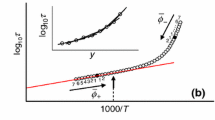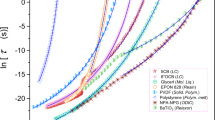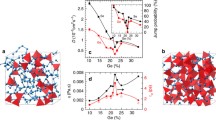Abstract
In the present study, we show that the range of the temperature ratio TA/Tg for fragile glass-forming liquids is predicted by adopting TA ~ Tx, where TA is the temperature that the Arrhenius crossover appears and Tx is the cooperativity onset temperature extracted from the Bond Strength–Coordination Number Fluctuation model proposed by the authors. Specifically, when the above relation is used in conjunction with the two-thirds rule (Tg/Tm = 2/3) and the empirical criterion for good glass-formers (TA/Tm \( \gtrsim \) 1.0), the predicted range of the Arrhenius crossover is calculated to be 1.5 \( \lesssim \) TA/Tg < 2.1. This range is in good agreement with the values confirmed in fragile systems, encompassing a wide range of glass-forming materials, excepting the network systems.


Similar content being viewed by others
REFERENCES
Sun, M., and Yao, X., Volume heterogeneity in liquid Cu near the dynamical crossover temperature Ta, J. Non-Cryst. Solids, 2021, vol. 556, p. 120559.
Ren, N., Hu, L., Wang, L., and Guan, P., Revealing a hidden dynamic signature of the non-Arrhenius crossover in metallic glass-forming liquids, Scr. Mater., 2020, vol. 181, pp. 43–47.
Jaiswal, A., Egami, T., Kelton, K.F., Schweizer, K.S., and Zhang, Y., Correlation between fragility and the Arrhenius crossoer phenomenon in metallic, molecular, and network liquids, Phys. Rev. Lett., 2016, vol. 117, p. 205701.
Angell, C.A., Relaxation in liquids, polymers and plastic crystals—strong/fragile patterns and problems, J. Non-Cryst. Solids, 1991, vols. 131–133, pp. 13–31.
Sanditov, D.S., Mashanov, A.A., Sanditov, B.D., and Mantatov, V.V., Fragility and anharmonicity of lattice vibrations of glass-forming systems, Glass Phys. Chem., 2008, vol. 34, pp. 389–393.
Zografi, G., and Newman, A., Interrelationships between structure and the properties of amorphous solids of pharmaceutical interest, J. Pharm. Sci., 2017, vol. 106, pp. 5–27.
Kokshenev, V.B., Characteristic temperature of liquid–glass transition, Phys. A (Amsterdam, Neth.), 1999, vol., 262, pp. 88–97.
Aniya, M., A model for the fragility of the melts, J. Therm. Anal. Calorim., 2002, vol. 69, pp. 971–978.
Ikeda, M. and Aniya, M., Understanding the Vogel–Fulcher–Tammann law in terms of the bond strength–coordination number fluctuation model, J. Non-Cryst. Solids, 2013, vols. 371–372, pp. 53–57.
Ikeda, M. and Aniya, M., A measure of cooperativity in non-Arrhenius structural relaxation in terms of the bond strength–coordination number fluctuation model, Eur. Polym. J., 2017, vol. 86, pp. 29–40.
Ikeda, M. and Aniya, M., Analysis and characterization of the transition from the Arrhenius to non-Arrhenius structural relaxation in fragile glass-forming liquids, J. Therm. Anal. Calorim., 2018, vol. 132, pp. 835–842.
Kauzmann, W., The nature of the glassy state and the behavior of liquids at low temperatures, Chem. Rev., 1948, vol. 43, pp. 219–256.
Sakka, S. and Mackenzie, J.D., Relation between apparent glass transition temperature and liquidus temperature for inorganic glasses, J. Non-Cryst. Solids, 1971, vol. 6, pp. 145–162.
Surovtsev, N.V., On the glass-forming ability and short-range bond ordering of liquids, Chem. Phys. Lett., 2009, vol. 477, pp. 57–59.
Koštál, P., Hofírek, T., and Málek, J., Viscosity measurement by thermomechanical analyzer, J. Non-Cryst. Solids, 2018, vol. 480, pp. 118–122.
Soklaski, R., Tranz, V., Nussinov, Z., Kelton, K.F., and Yang, L., A locally preferred structure characteristics all dynamical regimes of a supercooled liquid, Philos. Mag., 2016, vol. 96, pp. 1212–1227.
Tanaka, H., Two-oder-parameter model of the liquid–glass transition. I. Relation between glass transition and crystallization, J. Non-Cryst. Solids, 2005, vol. 351, pp. 3371–3384.
Ikeda, M. and Aniya, M., Linking the glass-forming ability to the Arrhenius crossover of structural relaxation, J. Non-Cryst. Solids, 2021, vol. 555, p. 120617.
Kondratiev, A. and Khvan, A.V., Analysis of viscosity equations relevant to silicate melts and glasses, J. Non-Cryst. Solids, 2016, vol. 432, pp. 366–383.
Ping, W., Paraska, D., Baker, R., Harrowell, P., and Angell, C.A., Molecular engineering of the glass transition: Glass-forming ability across a homologous series of cyclic stilbenes, J. Phys. Chem. B, 2011, vol. 115, pp. 4696–4702.
Novikov, V.N., connection between the glass transition temperature T g and the Arrhenius temperature T A in supercooled liquids, Chem. Phys. Lett., 2016, vol. 659, pp. 133–136.
Sanditov, D.S., Tsydypov, Sh.B., Sanditov, B.D., and Sangadiev, S.Sh., The hole-cluster model of vitreous solids and their melts, Glass Phys. Chem., 2000, vol. 26, pp. 223–225.
Cheng, S., Viscosity–temperature relation based on the evolution of medium-range structures of silica, J. Non-Cryst. Solids, 2021, vol. 557, p. 120582.
Aniya, M. and Ikeda, M., Arrhenius crossover phenomena and ionic conductivity in ionic glass-forming liquids, Phys. Status Solidi B, 2020, vol. 257, p. 2000139.
Pan, S., Wu, Z.W., Wang, W.H., Li, M.Z., and Xu, L., Structural origin of fractional Stokes-Einstein relation in glass-forming liquids, Sci. Rep., 2017, vol. 7, p. 39938.
Aniya, M. and Ikeda, M., The bond strength–coordination number fluctuation model of viscosity: Concept and applications, J. Polym. Res., 2020, vol. 27, p. 165.
Funding
This work was supported in part by JST CREST, Japan, JPMJCR1861 and JPMJCR18I2, and by JSPS KAKENHI nos. 21K04660, 20K05080, and 20H02430.
Author information
Authors and Affiliations
Corresponding author
Ethics declarations
The authors declare that they have no conflict of interest.
Rights and permissions
About this article
Cite this article
Masahiro Ikeda, Masaru Aniya Predicting the Temperature Range of Arrhenius Crossover of Structural Relaxation in Fragile Glass-forming Liquids. Glass Phys Chem 47, 427–430 (2021). https://doi.org/10.1134/S1087659621050072
Received:
Revised:
Accepted:
Published:
Issue Date:
DOI: https://doi.org/10.1134/S1087659621050072




